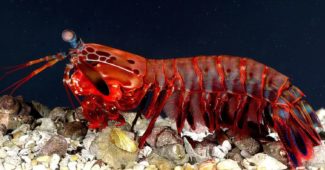Do you enjoy cool things? What about animals – do you find them cool because of their appearance, looks, or attitude? Certain animal species have impressive features that make them quite fashionable.
Here, we will explore the top 10 animals in the world that possess unique and remarkable traits that make them stand out as super cool.
10Okapi
The Okapi, also called the zebra giraffe, is a member of the Giraffidae family and is endemic to the Northeast Democratic Republic of the Congo. Due to its striped markings, Okapi looks like a zebra, but it has a long neck and large, flexible ears that are more similar to a giraffe.
Because they live in dense rainforests, the stripes on their legs are excellent camouflage that helps them stay safe. Their reddish-brown velvety fur produces oil that waterproofs their skin so that they can adapt to their environment. Okapis communicate with each other using low-frequency sounds that are beyond human hearing.
9Fossa
The Fossa is a carnivorous mammal with a cat-like appearance and long tail. It is native to Madagascar and is the largest of its kind. Fossas resemble a mix of cats, dogs, and mongooses. Their bodies are slender with short, reddish-brown fur and muscular limbs.
Fossas are skilled hunters, capable of hunting both on the ground and in trees during day and night. They use scent glands on their chest to communicate, and their long, slender tail helps them maintain balance while moving through trees. Interestingly, Fossas prefer to live in solitude.
10 Amazing Animals You Probably Didn’t Know Exist
8Maned Wolf
They are monogamous but most often seen in solitary. Interestingly, they consume up to 50% plant matter in their diet instead of primarily consuming animal protein. The Maned Wolf shares its habitat with the crab-eating and hoary fox to avoid competition for different prey items.
7Blue Dragon
The Blue Dragon is a sea slug commonly found in the open ocean’s Pelagic zone. They have a unique way of floating upside down, relying on the water’s surface tension to stay afloat. When viewed underwater, their silver/grey side blends in with the sunlight reflecting on the ocean’s surface. These slugs often form “blue fleets” to aid feeding and mating.
However, they can be dangerous to predators as they store stinging nematocysts in their tissues. This defense mechanism can cause painful and potentially harmful stings to humans. They don’t make good pets because finding the food they need at a pet store is impossible.
6Japanese Spider Crab
The Japanese Spider crab is found in the waters surrounding Japan and is known for its remarkably long legs. Despite its appearance, these crabs are gentle creatures of the ocean and serve as scavengers, combing the ocean floor for deceased animals or plants. They can regenerate their legs.
These decorator crabs decorate their shells using plants, sponges, and anemones to escape from predators and other threats. They are similar in appearance to the smaller European spider crab. Unfortunately, they are considered a delicacy in Japan, which has led to conservation efforts being put in place to protect and preserve their population from overfishing.
5Slow Loris
The Slow Loris is a cute animal commonly found in Southeast Asian rainforests and adjacent areas. These nocturnal primates have large eyes that impart cuteness but can only see one color. Despite their adorable appearance, they are venomous mammals that use their venom for hunting and self-protection.
One fascinating fact is that they have two tongues – one is for drinking nectar from fruits, while the other is rougher and functions as a toothbrush to keep their teeth clean. In Indonesia, people refer to them as “malu malu” or “shy ones” because they tend to freeze and cover their faces with their hands when startled.
4Angora Rabbit
The Angora rabbit is a fluffy domestic rabbit with a thick coat, regularly sheared to extract long fibers known as Angora wool. This wool is commercially significant and allergy-free. There are four types of Angora rabbits: French, English, Giant, and Satin.
They are lively and playful and enjoy companionship with their owners, other rabbits, and sometimes even cats. Angora bunnies require a lot of hay in their diet to help them digest the fur they ingest while grooming themselves. Not eating enough hay can cause the fur to get stuck in the digestive tract.
3Pacu Fish
The Pacu Fish is an omnivorous freshwater fish from South America, related to the piranha. What’s interesting about the Pacu is its teeth, which resemble human teeth and allow them to crush crustacean shells and fishermen’s hooks. Unlike piranhas, Pacus primarily feed on plant material rather than flesh or scales.
The red-bellied Pacu is the most well-known species, with vivid red scales on the ventral surface of their body. Sometimes called vegetarian piranhas because of their characteristic of eating plant material and decaying plant matter. Certain Pacu species, such as Swish from Washington, USA, exhibit unique personalities.
2Red-lipped Batfish
The Red-lipped Batfish is a rare fish found commonly in Peru and the Galapagos Islands. What makes them unique is their bright red lips that resemble lipstick. Unlike other fish, they are not strong swimmers but have adapted pelvic, pectoral, and anal fins that allow them to “walk” on the ocean floor.
When they become adults, their dorsal fins become a single spine-like projection, which helps them catch prey. Predators do not often threaten them because they live in deep water areas. Interestingly, they are named Ogcocephalus darwini in honor of Charles Darwin.
Related Articles
1Axolotl
The most astonishing fact about Axolotl is its incredible ability to regenerate lost limbs and body organs. Instead of lungs, they have feathery-looking gills on either side of their head that develop during the pre-mature stage. Additionally, the Axolotl has a natural resistance to cancer over 1,000 times higher than any other mammal.




